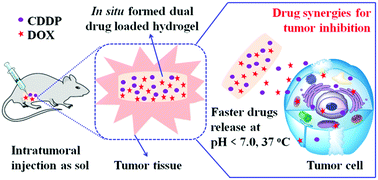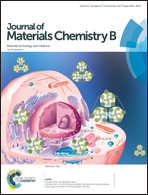Development of a dual drug-loaded hydrogel delivery system for enhanced cancer therapy: in situ formation, degradation and synergistic antitumor efficiency
Abstract
Herein, a dual drug-loaded hydrogel delivery system was constructed using aldehyded pullulan (A-Pul), ε-poly-L-lysine (ε-PL), and branched polyethylenimine (BPEI) in an aqueous solution via a Schiff base reaction. CDDP and DOX were loaded into the network of hydrogels for combination drug therapy. Gelation time changed from 40 s to 240 s when reaction solutions were stored at different temperatures. Scanning electron microscopy images and swelling dynamics demonstrated that the hydrogels had a homogeneous porous structure and good swelling behavior. The in vitro degradation rate and drug release rate at pH 7.0 were faster than those at pH 7.4; this indicated that the hydrogels displayed controlled drug release and pH-dependent behavior. The hydrogels could be injected and formed in situ and degraded in vivo, and the dual-drug-loaded hydrogel displayed the most efficient tumor inhibition; this indicated the synergistic anticancer effect of the CDDP + DOX combination therapy in H22 liver tumor-bearing mice. Furthermore, the hydrogels displayed no cytotoxicity against Huh-7 cells and exhibited excellent security and biocompatibility in vivo. Therefore, the hydrogels have potential applications as multidrug carriers for enhanced synergistic therapy.

- This article is part of the themed collection: 2017 Journal of Materials Chemistry B HOT Papers


 Please wait while we load your content...
Please wait while we load your content...